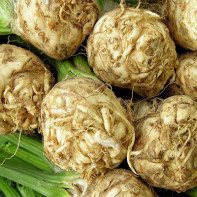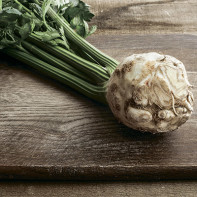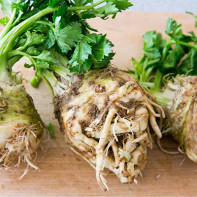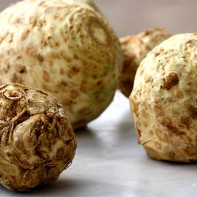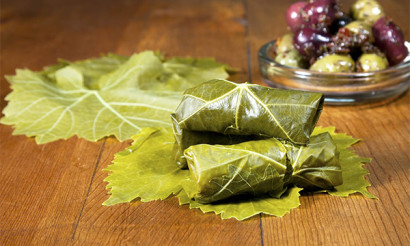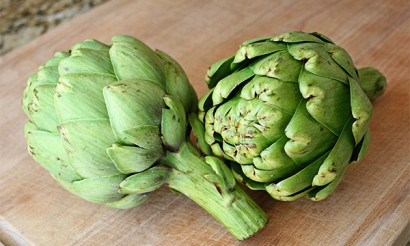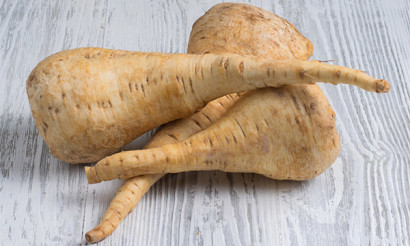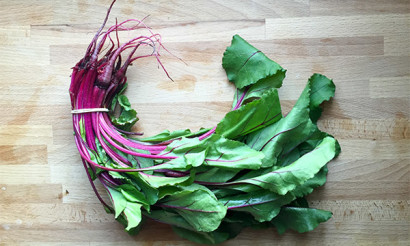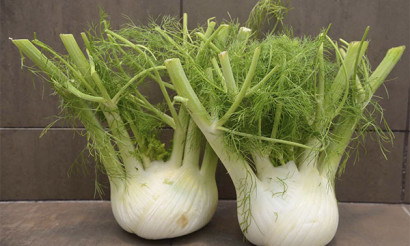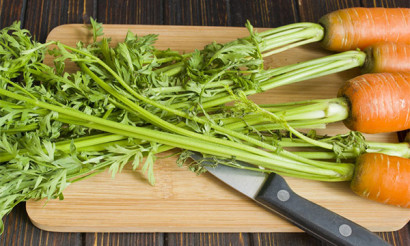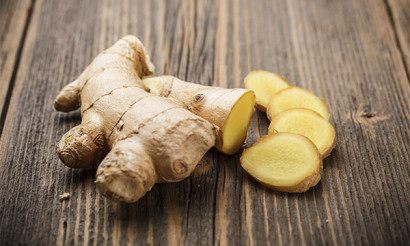Celery root: health benefits or harms
Celery is one of the most useful plants for humans. Moreover, all its parts are useful - greens, and roots, and seeds (and petioles - in the corresponding varieties). However, celery root, which contains a lot of biologically active substances and fiber that normalizes the functioning of the digestive tract, is especially appreciated in dietetics. It is available almost throughout the year, although the most delicious root crops are sold in stores and in markets from September to April.
- Composition and calorie content
- Useful properties of celery root
- General benefit
- For women
- For men
- During pregnancy
- When breastfeeding
- For children
- When losing weight
- Celery root in medicine
- Against salt deposits
- Against rheumatism and joint pain
- Against insomnia
- Against allergic reactions
- Harm and contraindications
- How to choose and store
- Is it possible to freeze
- How to dry
- How to eat celery root
- How much can you eat per day
- How to clean
- What can be cooked from celery root: recipes
- Celery Root Soup
- Potato with celery
- Celery, pumpkin and lentil casserole
- Salad with celery root and remoulade sauce
- Roasted Herb Celery Root
- Interesting facts about celery
Composition and calorie content
The energy value of celery root is only 34 kcal per 100 g. At the same time, it contains many useful substances.
There is practically no fat in celery root, and it contains only 2–4% sugar (for comparison, in greens - no more than 1%). Most of the volume is dietary fiber, which normalizes digestion. In addition, root crops contain:
- Ascorbic acid, which normalizes the immune system and improves the condition of blood vessels.
- Choline and B vitamins and PP vitamins, which are necessary both for the normal functioning of the central nervous system, and for active metabolism.
- Organic acids, including oxalic, some of them have antioxidant properties, that is, they have an anti-inflammatory effect and slow down the process of premature aging.
- Minerals are salts of potassium, phosphorus, calcium, sodium, without which metabolic processes could not have occurred at all.
- Glycosides and essential oils.
The properties of all these substances (and their combinations) are very multifaceted, so many tend to consider celery a cure for all diseases. This, of course, is not so, although studies of the properties of the root crop are very active, and it is considered a promising raw material for the pharmaceutical industry.
However, everything has a flip side, and celery is no exception. In particular, it contains very strong allergens that are not destroyed even by heat treatment. Moreover, their root contains more than in greenery (although less than in seeds). These substances can provoke extremely severe allergic reactions, even anaphylactic shock.
Useful properties of celery root
General benefit
These root crops have a variety of useful properties. For example, they have a mild diuretic effect, therefore, celery is recommended to be included in the diet for people suffering from puffiness, as well as for certain problems with urination and even with small kidney stones. The root in such cases can be consumed raw or squeezed juice from it.
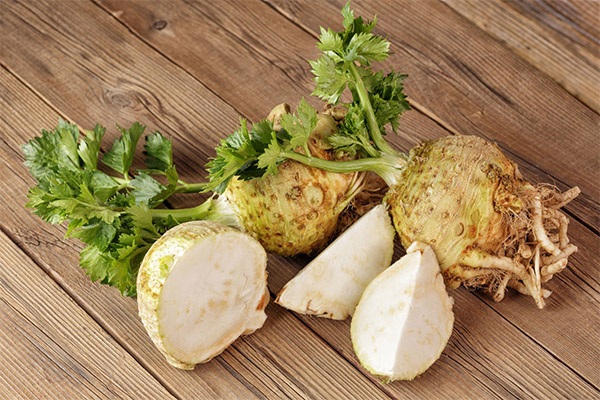
Its useful properties are not limited to this. It should be mentioned that celery root:
- Improves digestive processes due to the high content of dietary fiber. At the same time, there are research data that prove that in large quantities, fiber protects against cancer of the intestine. But this is not all - fiber also creates favorable conditions for the development of beneficial intestinal bacteria, which help prevent diseases such as diabetes and obesity.
- Prevents the development of atherosclerosis.In general, celery root is recommended for use in various cardiovascular diseases, including arterial hypertension, that is, high blood pressure. At the same time, celery extracts are not as useful as eating its root.
- It contains antioxidants that suppress inflammatory processes and protect the body at the cellular level, which is the prevention of many ailments, including malignant tumors, cardiovascular pathologies and Alzheimer's disease. Ferulic and caffeic acids and flavonoids (for example, quercetin) contained in celery root are considered especially useful.
- Improves brain function and has beneficial effects on cognitive abilities.
- Helps the body recover from surgery and serious illnesses.
- It suppresses the action of stress hormones and has a beneficial effect on the functioning of the nervous system as a whole. It can be compared with a mild sedative of plant origin.
- Supports the work of the heart muscle - due to the high potassium content. This element allows you to neutralize the effects of abuse of salt.
- Protects the liver from the development of fatty hepatosis.
- It is a fairly strong aphrodisiac.
The anti-inflammatory properties of celery root allow it to be used in the treatment of infectious and skin diseases and even pathologies such as gout and arthritis - antioxidants seriously alleviate such conditions.
The antitumor properties of celery root have not been sufficiently studied. However, there were several large-scale studies that showed that antioxidants and the vitamin composition of celery make it a promising tool in the fight against cancer.
Also, a number of studies allow scientists to believe that eating celery root could prevent the development of gastric ulcer. In particular, root crops contain a specific type of ethanol, which helps depleted mucous membranes. But how to use this property in practice, given the fact that celery essential oils are contraindicated in gastritis and ulcers, is not yet clear.
For women
For the fair sex, celery root is interesting in that it contains fiber, which helps to establish digestion and at the same time contributes to weight loss. But this is not his only advantage.
All parts of the plant, and the root too, contain the apiol element. It is a hormone-like substance that in many ways acts like estrogen. Therefore, regular use of celery root helps to establish the menstrual cycle and eliminate the most unpleasant manifestations of PMS, and also significantly improves the condition with menopause.
For women during menopause, celery root is especially beneficial in that it contains a lot of vitamin K and phosphorus. Both of these elements are very important for strengthening bones, their regular intake significantly reduces the risk of osteoporosis, the development of which threatens women during this period.
In addition, celery root contains antioxidants that have anti-inflammatory properties and can slow down the aging process. The rich vitamin composition of the root helps to improve the condition of the skin, hair and nails.
For men
Celery root must be included in the diet of men, because it contains plant hormone-like substances - in this case, affecting potency. In fact, celery is a safe analogue of the drug Viagra. You can add raw celery root to the diet or prepare freshly squeezed juice from it, and both options will give a good effect.
Men are more at risk than cardiovascular diseases than women.For them, eating celery root is also good because it helps to reduce the level of "bad" cholesterol in the blood. Studies have shown that 3-n-butylphthalide, which has a hypolipidic effect, is present in this root crop. Simply put, it lowers the level of low density lipoproteins and thereby reduces the risk of cholesterol plaques, which could lead to extremely negative consequences.
During pregnancy
Although celery is generally healthy, it can only be consumed in very small amounts during pregnancy, especially in the first and third trimester. The fact is that the above-mentioned substance apiol acts as estrogen, the level of which decreases during pregnancy. This means that it stimulates uterine contractions, which can lead to miscarriage or premature birth. However, you can use it in a small amount - it will give the body a sufficient amount of fiber and vitamins.
When breastfeeding
For young mothers during lactation, celery root is useful in that it allows you to quickly get in shape. But it contains a lot of essential oils, so at least the first two months when breastfeeding, it is better not to use this product so that milk does not have an unusual taste and the baby does not develop an allergy.
For children
Celery contains many vitamins and minerals that are beneficial for the baby. For example, this is calcium, which is necessary to strengthen teeth and bones, as well as potassium, which has a beneficial effect on the state of the cardiovascular system as a whole. In addition, celery root contains a lot of sodium, which reduces the use of salt in the diet of a child. There is also a lot of phosphorus in this vegetable, which is necessary for improving cognitive functions.
However, pediatricians advise introducing celery root into a child’s diet, only starting at a year and a half. In this case, at first it is worth adding only a small piece of root vegetables to the soup and checking the reaction, since this vegetable contains potential allergens, and the pronounced smell of celery may not be pleasant to the baby. It is necessary that the child gets used to it. At first, this piece of celery is ground in a blender along with the rest of the vegetables, then simply cut into small cubes.
When the child is two years old, it will be possible to offer him mashed celery. The dish is prepared as follows - for 100 g of celery root, take 20 g of crumb of white bread, 50 ml of milk, 1 teaspoon of soft butter, 1 egg and salt to taste. Celery is peeled and diced, and then boiled in slightly salted water. The bread is soaked in milk, then, together with butter, whisk everything with a blender. Hard boiled egg, cut into slices and used for decoration.
When losing weight
Celery, unfortunately, does not have fat-burning properties, but it can also be useful for losing weight. It is often said about it that it is a product with a negative calorie content, saying that when it is consumed, a person loses more calories when digested than he receives with the product. This is not entirely true, since the human body is able to extract energy from any product, even low-calorie. Just, unlike potatoes, celery practically does not contain starch (only 5-6% of the total), but it contains a lot of fiber. This helps to cleanse the body of toxins, and at the same time, intestinal activity is stimulated and the metabolic process is activated. All this taken together and helps to lose weight.
Those who are seriously engaged in a healthy diet can include celery root in their diet as a side dish for meat, as it will be better absorbed. From a nutritional point of view, this will be a great option - boiled chicken breast and celery and apple salad or a rabbit stewed with celery root and onions.
Also, a good effect is given by a diet on celery soup. Its essence lies in the fact that during the day you can eat only this soup, but in any quantities.Soup is prepared as follows: take 5 tomatoes per 300 g of celery root (in winter you can take canned, but not pickled), 300 g of white cabbage, 2 bell peppers, 1 carrot and greens. The vegetables are chopped and thrown into boiling water, brought back to a boil (it takes about 10 minutes), and then cooked over low heat until cooked. A few minutes before turning off the fire, chopped greens are thrown into the pan.
Adhere to this diet for a week. During this time, you can lose 3-4 kg of excess weight.
Celery root in medicine
Celery root is widely used in folk medicine. For instance:
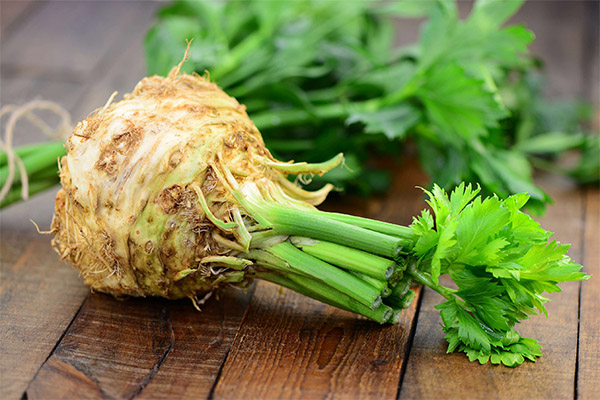
Against salt deposits
Take 40 g of peeled root per 1 liter of cold water and insist for eight hours (best left overnight). Then filter the infusion through cheesecloth and take 1 tbsp. spoon three times a day. There is another option - three times a day for half an hour before the main meals take freshly pressed celery juice.
Against rheumatism and joint pain
Take 1 tbsp. teaspoon of chopped celery root in 2 cups boiling water and left to infuse for 4 hours, and then passed through folded cheesecloth. Take infusion three times a day for 2 tbsp. tablespoons half an hour before meals. This remedy is considered effective against gout.
Against insomnia
Take 3 tbsp. tablespoons of grated celery root in 1 liter of cold boiled water and insist for eight hours, and filtered before use. Drink three times a day for 1 teaspoon.
Against allergic reactions
Freshly squeezed juice from the root is taken 2 teaspoons three times a day half an hour before the main meals, but only if there are no allergic reactions to celery and cross allergies.
Celery root is also used to treat frostbite. To do this, 200 g of dried root vegetables is poured into 1 liter of water, brought to a boil and kept on fire for 10 minutes. After that, it is cooled to an acceptable temperature and put in this liquid frostbitten limb for about 15-20 minutes. After that, the skin is treated with baby cream. The procedure is repeated for seven days.
Harm and contraindications
In some cases, eating celery root is contraindicated. As already noted above, this root crop should not be consumed during pregnancy. In addition to the fact that celery can cause uterine contraction, a large amount of fiber can provoke increased gas formation, since during pregnancy the intestines already experience pressure from the grown uterus.
In the presence of kidney stones, celery juice is prohibited, as it can cause calculus movement. But you can eat fresh celery, because this way its active substances enter the body in lower concentrations.
In renal failure, the use of root celery is contraindicated due to the high content of potassium and phosphorus. In addition, due to the diuretic effect, it cannot be used in conjunction with diuretics.
Contraindication to use is also poor coagulation. And if this pathology is combined with taking warfarin, then celery is definitely better to refuse.
Celery is used with caution with increased acidity of the stomach, since with such a content of essential oils it only increases the production of gastric juice.
How to choose and store
Celery can easily be found for sale in stores and markets from September to April, so it is not necessary to freeze it for the winter. Unless you can consider this as a way of storage during processing of the crop from your own summer house.
Is it possible to freeze
Like any other vegetables, quality celery can be frozen. For this, root crops are washed, dried and peeled, knots and roots. You can freeze both grated celery on a coarse grater, and chopped into small pieces. In any case, it is packaged in plastic bags or plastic food containers, and then put in the freezer.
How to dry
For drying, the celery root must first be chopped - either grated on a coarse grater, or cut with a sharp knife with a long straw, or peeled and cut into thin slices using a peeler.
Chopped celery can be dried naturally without interfering with the process by spreading it on wire racks or trays. It is not recommended to substitute it under direct ultraviolet rays, it is better to keep it under a canopy and mix the crushed mass from time to time. Drying will take at least two weeks. You can speed up the process if you dry it in the oven at a temperature close to the minimum by slightly opening the door. It is most convenient to dry in a special dryer. The temperature in it is the same as in the oven - 50 degrees. The drying process takes 10 hours.
How to eat celery root
With all its useful properties, celery requires a careful approach due to excess fiber, which causes gas formation, and essential oils.
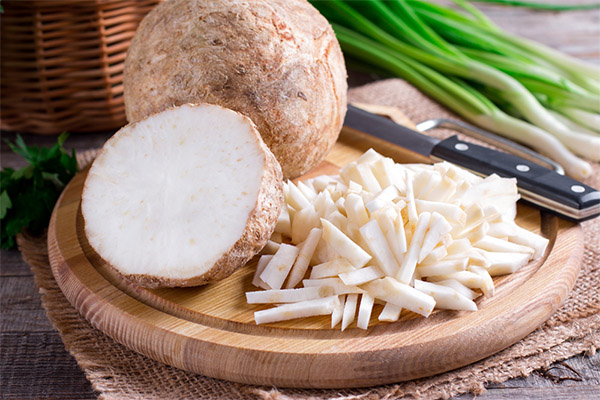
How much can you eat per day
Of course, for each person the norm will be individual, but in general, 300 g per day in raw, boiled and fried form will be quite enough.
How to clean
The answer to this question depends on how economically the hostess wants to clean the celery. If speed is the main thing, then you can quickly cut the root crop into two parts, and then with each of them cut the peel and knotted roots in just a few movements. But then a lot of the pulp will go to waste.
For a more economical cleaning, you must first cut off the top, to which the stems of greenery are attached. Then gently cut the peel with a thin layer, and where the knotted roots are located, remove only them, and clean all the “cavities” between them with a knife and then try to peel the peel with a thin layer there too. It will take much longer, but most of the pulp will remain.
If the root is not going to be used completely, you need to cut a small piece and clean it only, and wrap the rest in plastic wrap.
What can be cooked from celery root: recipes
A variety of dishes can be prepared from celery root. Its pulp has a strong aroma, but by itself it is not eaten, except in a salad, with herbs and dressing. Raw celery root goes well with apples and herbs, as well as carrots and pumpkin, which allows you to cook a lot of salads and snacks from it.
Boiled and stewed, it is good in combination with potatoes, mushrooms, meat and even seafood, it all depends solely on the sauce and additional spices. Celery can be added to soups, vegetable stew, pickles. From celery, even without additives, a delicious cream soup is obtained. But you can try other options for dishes:
Celery Root Soup
Take 1 root vegetable, 2 stalks of leek (and only the white part), a glass of 33% cream, 2 tbsp. tablespoons of olive oil, 2 tbsp. tablespoons of flaxseed or sesame seeds. Celery and leek are thoroughly washed. A deep longitudinal cut is made in leek to get rid of all the impurities. Both the root crop and the onion stalks are coarsely chopped and stacked in a pan so that the water covers the vegetables. The mixture is brought to a boil, then the fire is reduced to a minimum and left under a closed lid for 20-30 minutes. When the celery becomes soft, beat it with a blender until smoothie, add cream and mix everything. Salt and pepper are added to taste. When serving, sprinkle with seeds and chopped herbs.
Potato with celery
Take 400 g of potato and the same amount - celery root, 1 large white onion, a handful of fresh thyme leaves, 2-3 tbsp. tablespoons of vegetable oil, salt to taste. They wash the potatoes in the usual way, peel them and cut into medium-sized cubes. Do exactly the same with celery.Then chop the onion and fry for several minutes with thyme in a non-stick pan. After 3-4 minutes, celery and potatoes are added there and mixed. All this is stewed under a lid over low heat for 15-20 minutes until the vegetables are ready. So that the dish does not burn, it must be constantly stirred, in extreme cases, you will have to add a small amount of hot water, but best of all - dry white wine. It will give the dish a richer flavor. Salt and spices are added at the end of the cooking process and the ingredients are mixed again.
Celery, pumpkin and lentil casserole
For this dish you will need the following ingredients: 1 large celery root, 300 g pumpkin pulp and a couple of medium-sized carrots, 60–70 g brown lentils, 1-2 onions, 2-3 cloves of garlic, a pair of thyme and rosemary twigs, 2 tbsp. tablespoons of olive oil, 2 teaspoons of balsamic vinegar and the same amount of soy sauce, 0.4 l of vegetable broth. Also need 150 g of good hard cheese, 50 ml of milk, salt and pepper to taste. Onions, pumpkin and carrots are cut into small pieces, the leaves of spicy greens are chopped, and garlic is passed through a press. First, onion is slightly fried in a pan with a thick bottom, then garlic, thyme and rosemary, a little balsamic vinegar are added to it, mixed and left on fire for literally a minute. After this comes the turn to add other vegetables, lentils and spices. After a few minutes, pour the vegetable broth, add soy sauce and bring to a boil. Cook vegetables for 45 minutes until lentils are soft.
Meanwhile, they clean the celery root and cut it into cubes, and then boil it in salted water, adding garlic. After the celery is ready, it is transferred to a blender bowl, olive oil and milk are added there and beat mashed potatoes. Ready-made vegetables with lentils are spread in the greased form, and celery puree is placed on top. The surface is leveled and sprinkled with grated cheese, and then baked in the oven until a crust appears.
Salad with celery root and remoulade sauce
The latter is a traditional sauce of French cuisine with capers, but you can do without them, especially since it exists in many versions. To prepare the dish you will need such products: 1 large celery root, a glass of homemade mayonnaise, one hard-boiled chicken egg, 1 tbsp each. a spoonful of chopped parsley and tarragon, a clove of garlic, 0.5 teaspoon Dijon mustard with grains. The sauce is prepared as follows - egg whites and yolks are separated. The protein is crushed, and the yolk is ground with a spoon of mayonnaise, and then it is added to the remaining mayonnaise, put chopped garlic, parsley, tarragon and mustard there. Celery is peeled and cut into thin slices, then tossed in boiling water and boiled for 3-4 minutes. Then the water is drained, the celery is cooled, cut into thin strips and seasoned with remoulade sauce. Sprinkle with herbs before serving.
Roasted Herb Celery Root
For cooking, you will need a large celery root (about 0.5 kg), 2 tbsp. tablespoons of olive oil, 2-3 cloves of garlic, a sprig of fresh rosemary and a handful of mint leaves. Salt and ground black pepper are added to taste. Celery root is first cut into slices with a finger thick, then divided into slices. Fry the vegetable in preheated olive oil until a golden crust appears. After that, the fire is removed to a minimum, chopped garlic and rosemary are added to the pan, and fried together for 4–5 minutes. When the celery becomes soft, add a little butter and mint, season with salt and pepper, mix, without removing from the heat. Before serving, excess oil is drained.
For any of these recipes, you need a good celery root.It is advisable to choose it correctly: the root crop should be solid, with a smooth surface and without knots, which then still have to be disposed of. It is important that inside it is complete, without voids. To check this, you need to tap on the root crop. A quality one will have a dull sound, sonorous is characteristic of an empty vegetable inside.
Interesting facts about celery
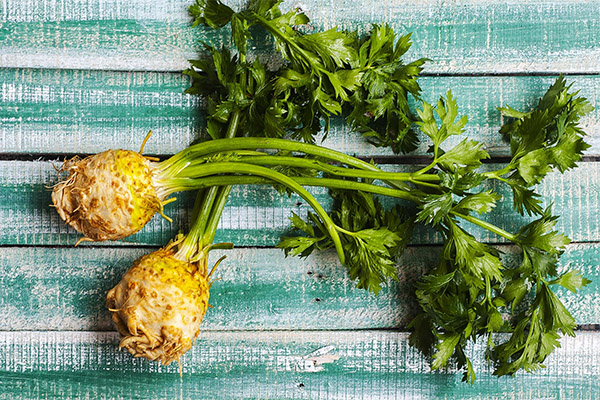
From the point of view of botany, celery belongs to the Umbrella family and is a relative of parsley and carrots, although it differs from them in appearance, taste and aroma. It is curious that its healing properties were well known in ancient Greece. The legendary Hippocrates in his writings described the action of celery in various diseases. At the same time, they did not eat it, because the wild varieties grown in the Mediterranean were bitter, and the first tasty varieties were bred only 18 centuries later.
But in Russia, celery appeared only under Catherine the Great - and at first it was an ornamental plant, although even then the court beauties knew that it was incredibly useful for skin and hair. But for many years, celery just decorated the gardens like an overseas guest. And its name itself came from the German name, which in turn went back to Latin. Now the memory of this has been preserved only in the Ukrainian language, where celery is called "celery".
«Important: all information on the site is provided exclusively in fact-finding purposes. Before applying any recommendations, consult with a profile specialist. Neither the editors nor the authors are liable for any possible harm caused materials. "

